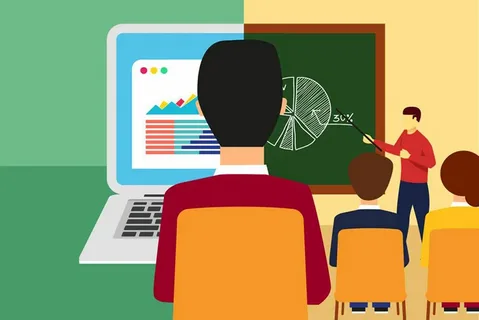
Special education is about helping students who need extra support to succeed in school. Individualized Education Plans (IEPs) are special plans made just for these students. This blog will explain how using technology, like School Management Systems (SMS), can make IEPs even better.
In this blog, you will learn:
- What IEPs are and why they are important.
- How School Management Systems work and their key functions.
- The benefits of combining IEPs with School Management Systems.
- How personalized learning can help students with special needs.
- Strategies for implementing personalized learning in special education.
Keep reading to discover how integrating IEPs with School Management Systems can make a big difference in the success of students with special needs.
What Are IEPs?
An Individualized Education Plan (IEP) is a special plan made for students who need extra help in school. It outlines the student's learning needs, the services the school will provide, and how progress will be measured. IEPs are designed to give each student the specific support they need to succeed.
Purpose and Importance of IEPs in Special Education
The main purpose of an IEP is to make sure each student with special needs gets the right help to learn and grow. IEPs are important because they:
- Provide a clear plan for the student's education.
- Ensure the student gets the specific services and support they need.
- Help teachers and parents work together to support the student.
- Track the student’s progress and make changes if needed.
IEPs help make sure that every student with special needs has the best chance to succeed in school.
Who Needs an IEP?
Students who have disabilities or learning difficulties and need extra support in school are the ones who need an IEP. This can include students with physical disabilities, learning disabilities, speech or language impairments, and other special needs. The goal of an IEP is to give these students the tools and support they need to achieve their full potential.
What is a School Management System (SMS)?
A School Management System (SMS) is a software tool that helps schools manage and organize their daily activities. This system takes care of many important tasks, such as:
- Student Information: Keeping track of student details like attendance, grades, and personal information.
- Schedules: Managing class schedules, timetables, and calendars.
- Communication: Helping teachers, parents, and students stay in touch through messages and updates.
- Reports: Generating reports on student performance and school activities.
How SMS Supports Educational Institutions
An SMS helps schools run more smoothly by:
- Organizing Information: Keeping all student and school information in one place makes it easy to find and use.
- Improving Communication: Teachers, parents, and students can easily share and receive important updates.
- Saving Time: Automating tasks like attendance tracking and report generation frees up time for teachers to focus on teaching.
- Enhancing Decision-Making: Schools can use data from the SMS to make better decisions about student needs and resources.
By using an SMS, schools can ensure they are organized, efficient, and able to provide the best support for their students.
Benefits of Integrating IEPs with School Management Systems
Integrating Individualized Education Plans (IEPs) with School Management Systems (SMS) offers many advantages. It helps create a more organized, effective, and supportive learning environment for students with special needs.
Individualized Educational Pathways
Combining IEPs with SMS allows schools to create unique learning paths for each student. This ensures that every student receives the personalized education they need to succeed.
Personalized Learning Plans
An SMS can help manage and update personalized learning plans. This means each student gets a plan tailored to their specific needs and goals, which can be adjusted as they progress.
Tracking Progress and Adjustments
With an SMS, teachers can easily track student progress and make necessary adjustments to their IEPs. This helps ensure that students are always getting the right level of support.
Enhanced Interaction
Communication Between Teachers, Parents, and StudentsAn SMS makes it easier for teachers, parents, and students to communicate. They can share updates, ask questions, and provide feedback, all in one place.
Real-Time Updates and Feedback
Parents and teachers can receive real-time updates on a student's progress. This immediate feedback helps everyone stay informed and involved in the student’s education.
Efficient Allocation of Resources
An SMS helps schools manage their resources more efficiently. This means they can better support students with IEPs by ensuring they have the necessary materials, staff, and time.
Data-Driven Decision Making
Using data from an SMS allows schools to make informed decisions. This data helps identify what is working and what needs improvement, leading to better educational outcomes for students.
Compliance and Accountability
An SMS helps schools comply with legal and educational standards. It ensures that all IEPs meet the required guidelines and that students receive the support they are entitled to.
Transparent Reporting and Documentation
All information about a student’s IEP is stored in the SMS, making it easy to generate reports and provide documentation. This transparency helps keep everyone accountable and ensures that students receive consistent support.
By integrating IEPs with School Management Systems, schools can provide more effective, personalized support for students with special needs. This integration makes it easier to track progress, communicate, and manage resources, ultimately helping students succeed.
How IEPs Are Developed and Implemented

The Development Process
Creating an IEP involves several steps to ensure it meets the student's needs:
- Assessment: Teachers and specialists evaluate the student’s abilities and challenges.
- Goals: Specific educational goals are set for the student.
- Services: The IEP outlines the services and support the student will receive.
- Plan Creation: The IEP is written down and agreed upon by the IEP team.
Who's on the IEP Team?
The IEP team includes:
- Teachers: They understand the student’s educational needs.
- Parents: They provide insights into their child's strengths and needs.
- Specialists: These may include speech therapists, occupational therapists, and psychologists.
- Administrators: They ensure the IEP meets school and legal requirements.
- The Student: When appropriate, the student can be part of the team to give their input.
How Are Services Delivered?
Services described in the IEP can be provided in different ways:
- In-Class Support: Additional help within the regular classroom.
- Special Classes: Separate classes for students who need more intensive support.
- Therapies: Services like speech therapy or physical therapy.
- Assistive Technology: Tools and devices that help the student learn.
Evaluation and Updates of IEPs
IEPs are regularly reviewed to ensure they are effective:
- Ongoing Monitoring: Teachers and specialists track the student’s progress.
- Regular Meetings: The IEP team meets at least once a year to review and update the plan.
- Adjustments: Changes are made to the IEP as the student’s needs evolve.
Role of Personalized Learning in Special Education

The Rise of Personalized Learning in Education
Personalized learning is becoming more popular in education. It focuses on tailoring education to meet individual student needs. In special education, personalized learning ensures that students with unique challenges receive the support they need to succeed.
By integrating personalized learning with IEPs, schools can provide customized educational experiences that help each student reach their full potential. This approach benefits all students, especially those with special needs, by providing a more engaging and effective learning environment.
Benefits of Individualized Education Plans in Personalized Learning
Differentiated Instruction
IEPs support differentiated instruction, where teaching methods are tailored to meet the diverse needs of students. This means:
- Variety in Teaching Methods: Using different ways to teach the same material so all students can understand.
- Pacing: Allowing students to learn at their own pace, taking more time if needed or moving ahead if they grasp concepts quickly.
Tailored Learning Accommodations
IEPs ensure that students receive specific accommodations to help them learn. These can include:
- Extra Time: More time to complete tests or assignments.
- Modified Assignments: Adjusting tasks to match the student's abilities.
- Support Tools: Using tools like calculators or graphic organizers to aid learning.
Integration of Adaptive Technologies
Using technology to support IEPs can greatly enhance personalized learning. This includes:
- Assistive Devices: Tools like speech-to-text software or audiobooks.
- Learning Apps: Educational apps that adapt to the student’s learning level and pace.
Strategies for Implementing Personalized Learning in Special Education
Competency-Based Learning
This approach allows students to progress based on their ability to demonstrate understanding, rather than time spent in a class. Benefits include:
- Mastery of Skills: Students move forward only when they have mastered the current material.
- Flexible Pacing: Students can take the time they need to learn each concept thoroughly.
Co-Teaching and Collaborative Approaches
Teachers work together to support students with special needs. This can involve:
- Shared Planning: Teachers plan lessons together to meet all students' needs.
- Team Teaching: Two or more teachers deliver instruction together.
Hands-On Learning Experiences
Practical, hands-on activities help students learn by doing. This includes:
- Experiments: Science labs or hands-on projects.
- Interactive Learning: Activities that involve physical movement or using tools.
Teacher Training and Mindset Shift
To successfully implement personalized learning, teachers need training and a shift in mindset:
- Professional Development: Ongoing training to learn new strategies and tools.
- Flexible Thinking: Being open to trying new approaches and adapting to student needs.
Individual Learner Profiles and Customization
Creating learner profiles helps in customizing education for each student. This involves:
- Detailed Profiles: Information about each student’s strengths, needs, and preferences.
- Customized Plans: Tailoring educational plans based on these profiles.
Challenges and Considerations
Common Obstacles in Personalized Learning
Implementing personalized learning can be challenging due to:
- Resource Limitations: Not enough time, staff, or materials.
- Resistance to Change: Difficulty in shifting from traditional teaching methods.
Ensuring Equity and Inclusion
It's important to ensure all students have equal access to personalized learning:
- Inclusive Practices: Making sure all students, regardless of their background or abilities, are included.
- Fair Access: Providing the necessary resources and support to all students.
Balancing Standardization with Individualization
Schools must find a balance between meeting standardized education requirements and individualizing learning:
- Core Standards: Ensuring students meet essential learning standards.
- Flexible Approaches: Allowing for individualized instruction within the framework of these standards.
The Role of Data in Personalized Learning
Benefits of Data-Driven Approaches
Using data helps in making informed decisions about student learning. Benefits include:
- Tracking Progress: Monitoring student achievements and challenges.
- Identifying Needs: Recognizing areas where students need more support.
Using Data to Enhance Student Outcomes
Data can be used to improve educational outcomes by:
- Personalizing Learning Plans: Adjusting plans based on data insights.
- Measuring Effectiveness: Evaluating the impact of different teaching strategies.
By leveraging the benefits of IEPs and integrating them with personalized learning strategies, schools can create more effective, supportive, and engaging learning environments for students with special needs.
Conclusion
Integrating Individualized Education Plans (IEPs) with School Management Systems (SMS) can greatly enhance the educational experience for students with special needs. By combining the personalized support of IEPs with the organizational power of SMS, schools can create individualized educational pathways, track progress, and improve communication between teachers, parents, and students.
This integration also ensures efficient resource allocation, data-driven decision making, and compliance with legal standards. Personalized learning, supported by IEPs, offers tailored instruction and accommodations that help each student reach their full potential.
By embracing these strategies and overcoming the challenges, schools can provide an inclusive and effective learning environment that caters to the unique needs of every student.
Ready to learn more about how technology can transform education? Check out our blog on "Transforming Learning: The Advantages of Online Homework and Assignments" for insights on how online tools can enhance learning and streamline assignments.